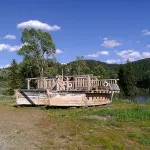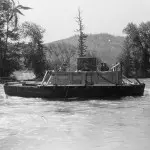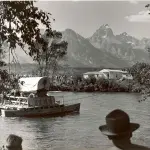Born in Ohio in 1857 in Ohio, William “Bill” Menor lived in several states before settling in Jackson Hole, Wyoming in 1894. He arrived in the valley and under the encouragement of Jack Shive and John Cherry, decided to open up a ferry service crossing the Snake River. Bill chose his parcel carefully, studying the river to find a location with easy access and the safest water. In order to own his property, he needed to prove up on the land by building a cabin and cultivating at least 5 acres. By 1908 when Menor received his patent, he had constructed a 5-room cabin, a storeroom, an ice house, a shed, a barn and related corrals. He also operated a small general store. Initially he cultivated 12 acres of land, cutting down to 5 in order to maintain the buildings and run the ferry during high water time. The summer was the busiest season for Menor, but he was still able to bring in some money during the winter months when the water was too low for a ferry by constructing a temporary bridge and charging a toll for those needing to cross. He removed the bridge and reinstated the ferry each spring when the river waters became too high and dangerous for bridge crossing.
Menor would be the sole homesteader on the west bank of the Snake River until 1911 when Jimmy Manges filed for a homestead near Timbered Island. Soon after, several other homesteaders moved onto the west bank area near Menor. In 1923 the need was high enough for the United States Postal Service to approve a post office for the area. William Grant named it Moose and became the first postmaster. Prior to this, the area was just known as “Menor’s Ferry.”
In 1918, after tiring of the long harsh winters and unpredictable summers, Bill Menor sold his land to his neighbors and moved to San Diego, California. Maud Noble, Frederick Sandell and May Lee purchase the land jointly, with Noble and Sandell later buying out Lee. Noble and Sandell continued to run the ferry, doubling prices and allowing automobiles to be shuttled over the river. Valley residents were incensed over the fee increase, but had little choice as the ferry was the only option to cross the Snake River between Jackson and Moran.
In 1924, with the increased visitor and local populations, the Bureau of Public Roads began construction on a highway connecting Jackson and Moose. By 1927, the Bureau completed a bridge over the Snake River which rendered the ferry redundant. With the safer and cheaper option of the bridge, Noble and Sandell ceased operations. The ferry would lie dormant for the next two decades until 1949 when Harold and Josephine Fabian assumed management of the historic district. Fabian worked as a lawyer for Rockefeller and was Vice President of the Snake River Land Company. He and his wife oversaw the restoration of the ferry and the historic district, and the ferry resumed crossing the river. It was now considered a historic resource that allowed visitors to ride for fun and experience a piece of history in the process. It continues to serve the same purpose today.
The only other options for crossing the Snake River at the time Menor’s ferry was operating was Conrad’s ferry and later Sheffield’s toll bridge in Moran, or the Jackson-Wilson bridge in Wilson. In 1917 the Wilson Bridge approaches were washed out, and due to disagreements over culpability and finances, the bridge would not be repaired until 1922. This meant that the ferry was extremely busy, as it was the only route to reach the town of Jackson from Teton Pass. Travelers and locals were forced to divert the 20 miles north to the ferry crossing. A cable car was strung across the Wilson Bridge in order to carry smaller supplies, but it was not really a workable replacement.
Because of the ferry and later bridge crossing at Moose, an increased amount of traffic was passing through the area. As a result, a convenience store, gas station, school and church were constructed in addition to the post office on the west bank. In the 1960s, it became the ideal location to house Park Headquarters, as well as the majority of employee housing. Today only the park headquarters facilities and post office exist on the west bank, with Dornan’s providing tourist services on the east side.
Today, Menor’s original general store is still open to the public, and many of his outbuildings still remain. Maud Noble’s cabin, along with the Chapel of Transfiguration, completes the historic district. The signature whitewashing on Menor’s cabin is still visible, having the distinction of being the only whitewashed buildings in the valley. The limekiln that provided the white pigment is still located across the river, on the former Holiday Menor (brother to Bill) property. The importance of Bill Menor’s ferry cannot be overstated in Jackson Hole’s history; it is one of the most visited historic sites in the park, as it was at the turn of the century for the locals needing to get safely across the Snake River.
TIMELINE
1894: William “Bill” Menor becomes the first homesteader to settle on the west bank of the Snake River. He files for a patent and begins to cultivate his land. The true purpose for this location is to open a ferry which would become the only safe river crossing between Jackson and Moran.
1896: First recorded use of the ferry by Maggie McBride. She remembers Bill Menor being unwilling to negotiate the cost for crossing. Menor saw the ferry as his source of income, rather than relying on the uncertainty of dry farming his land.
1907: First to secure water rights to Cottonwood Creek and builds a ditch to irrigate his fields and garden.
1908: Menor receives the patent for 148.53 acres after satisfying the requirements to “improve” upon the land. He has built a 5-room cabin, storeroom, shop, ice house, shed, barn and corrals.
1911: Menor’s solitary residence on the west bank is ended by the homestead of Jimmy Manges near Timbered Island. Others soon start to fill in the area, including William Grant, Harry Clissold, Bryant Mears, the Bar BC Ranch, Geraldine Lucas, and Maud Noble.
1918: Bill Menor, tired of the harsh seasons in Jackson Hole, sells his property to neighbors Maud Noble, Frederick Sandell and May Lee. Sandell and Noble later buy out Lee. Menor moves to San Diego, California where he dies in 1933. He is joined by his brother, Holiday Menor in 1928.
1924: The Bureau of Public Roads begins construction of a highway between Jackson and Menor’s Ferry.
1926-7: The Bureau of Public Roads begins construction of a bridge from Dornan’s on the east bank of the Snake River to Menor’s Ferry on the west bank.
1929: Maud Noble and Frederick Sandell sell the property to the Snake River Land Company. The ferry crossing is made redundant by the safer, cheaper bridge without tolls.
1949: Ferry operations are restored under the new management of the area by Harold and Josephine Fabian. Fabian worked as a lawyer for John D. Rockefeller Jr., and became the Vice President of the Snake River Land Company. The Fabians restored the Menor’s Ferry site as well as the nearby Maud Noble cabin.
1953: The property is handed over to National Park Service management.
Text by Samantha Ford, Director of Historical Research and Outreach






